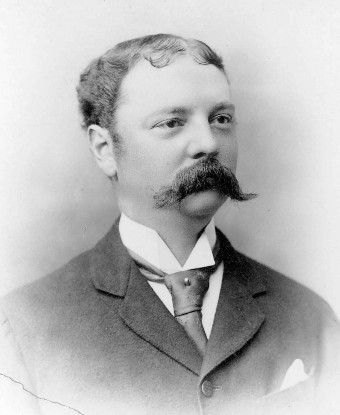Last updated: December 31, 2024
Person
Frederick Vanderbilt

Photo Courtesy of Biltmore Estate
Grandson of America’s first multi-millionaire, Commodore Cornelius Vanderbilt, Frederick Vanderbilt was born on February 2, 1856 at Staten Island, New York. Frederick was the third of eight children born to William Henry Vanderbilt (1821–1885) and Maria Louisa Kissam Vanderbilt (1821–1896). The family eventually relocated to Manhattan.
In an era of unregulated business practices that allowed his family to amass such tremendous wealth, Frederick’s father and grandfather, with their fellow robber barons, were the frequent subject of criticism and ridicule in the press. Growing up among public outcry against his family might have affected Frederick’s personality. By all accounts, as an adult, Frederick avoided publicity and society more so than his siblings.
Memories of friends and employees portray a man who was extremely shy, indicated by a story often told of his endeavors to avoid meeting people on the estate. His neighbor, President Franklin D. Roosevelt, recalled that Vanderbilt was once embarrassed when, to avoid meeting a servant on the grounds, he darted into the bushes, only to meet the servant who respectfully darted into the same bushes to avoid the employer.
Frederick graduated from Yale University Sheffield Scientific School in 1876, the only one of his siblings to attend college.
In 1878, Frederick married Louise Holmes Anthony Torrance (1854–1926), the daughter of Charles Lee Anthony and Catherine Anthony. Louise's father was a successful dry-goods merchant in New York City. She had been previously married, in 1868, to Frederick's cousin Alfred Torrance, before their divorce in 1877. It was reported that Frederick and Louise’s marriage generated some initial family disapproval and was the subject of public gossip.
In 1878 he entered the family’s New York Central Railroad, beginning his career as his father had done, as a clerk working his way through the various departments. He worked in minor jobs, submitted to the usual rules and regulations of the various offices, and won the commendation of department heads for his industry and application.
Frederick never retired. By the time of his death, he was a director of twenty-two railroads, the Western Union Telegraph Company, Hudson River Bridge Company, Detroit River Tunnel Company, Niagara River Bridge Company and the New York State Realty and Terminal Company. He followed the family tradition in keeping his business interests closely tied up with the transportation industry. His chief holdings were in the New York Central Railroad and directorships in other railroads stemmed from that system, with which the name of Vanderbilt has been linked since its beginning.
Frederick and Louise owned houses in Newport, Bar Harbor, Hyde Park, Manhattan, and a great camp in the Adirondacks.
Among his hobbies, Vanderbilt was known to play the banjo, he derived his chief pleasure in angling and outdoor sports, and was passionately devoted to yachting. He owned a series of elegant steam yachts, and together Frederick and Louise travelled on those yachts to Florida, Europe, South America, up the northeast coast, and to Hyde Park. After the death of his wife in 1926, he spent much of his year on his yacht.
Vanderbilt was a member of numerous clubs—the Metropolitan, University, Knickerbocker, Tuxedo, Yale, South Side, and Midday Clubs. He was also a member of the Larchmont, New York, and Sewanhaka-Corinthian Yacht Clubs.
Frederick gave generously to institutions, particularly to his alma mater, the Sheffield Scientific School at Yale University. His other contributions included $3.5 million to Vanderbilt University, $1.5 million (with his brothers and nephew) to establish the Vanderbilt Clinic (an outpatient clinic at Columbia University), $100,000 to the Red Cross War Fund during World War I, $100,000 to the Y.M.C.A., $50,000 for New York City unemployment relief during the Depression, $100,00 to the Cathedral of St. John the Divine. He also contributed to building the Sloan Hospital for Women and the Anthony Home for Working Girls founded by his wife.
Frederick was the only one of the third-generation Vanderbilts to increase his inheritance to a sizable fortune. In 1924, shortly after the income tax was introduced, he was one of the ten wealthiest taxpayers in America, paying $793,000 in taxes. When Frederick died in June of 1938, his net worth was reported to be $80 million. Over half was paid in estate and inheritance taxes, the federal government receiving over $31 million and the State of New York receiving over $12 million. Most of his weath was invested in security bonds valued at $68 million. The bulk of his stock holdings was invested in U.S. Steel. Over $20 million of his remaining estate was divided into a 100-share trust fund. The largest share went to his neice, Daisy Van Alen, and other bequests to charities, family, and long-time employees, including his valet, his assistant butler, and a house maid.
